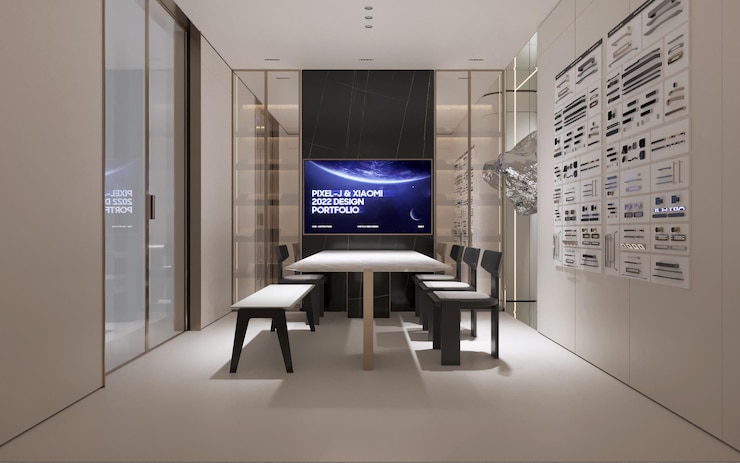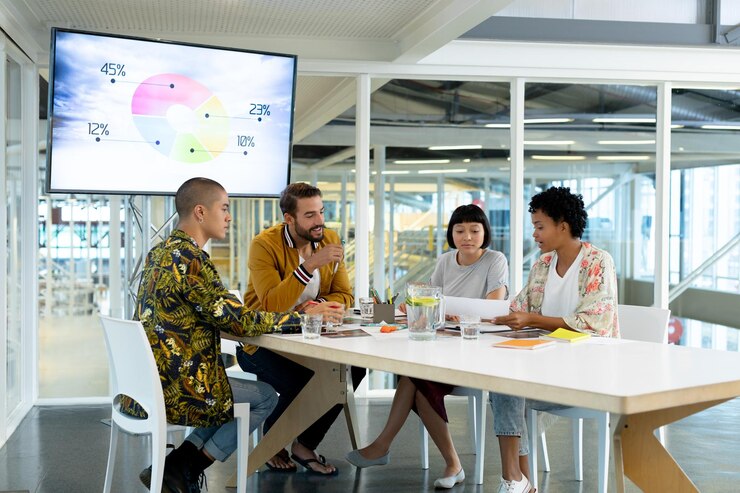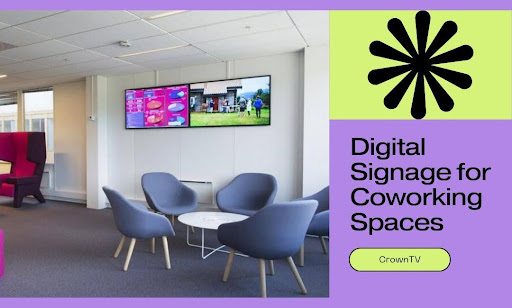Walk into any shared corporate office today, and the same pattern keeps popping up: screens are either sitting idle, running generic news loops, or flashing outdated slides from two tenants ago. That’s not signage — that’s dead space.
Here’s the real problem: most coworking spaces add screens after the fact, as decoration. They treat them like wall art with motion. But digital signage isn’t meant to blend in. It’s supposed to move people — shift behavior, share context, streamline what happens inside the space.
So why do most setups flop? Because no one lays the groundwork before plugging things in.
If you’re putting digital signage into a coworking space, don’t skip the upfront strategy. It affects everything — cost, screen quality, backend management, scalability, and more. Skip that, and you’ll end up with tech that looks sleek but does nothing.
In this article, we’ll cut through the noise and break down:
- What digital signage actually means in the context of coworking spaces (not the textbook version)
- How signage fits into shared spaces where screens serve multiple stakeholders
- The challenges unique to shared offices — and how to build around them
- Which screen and software specs matter before you buy
- What content management looks like once the system is live
- Why using CrownTV up front can eliminate messy installs, missed schedules, and software silos
This is the prep work that actually makes signage work. Let’s get into it.
What Digital Signage Really Does Inside a Coworking Space
Not every screen is signage. And not every signage setup belongs in a coworking space. If you’ve seen a screen running the weather, a stock ticker, or yesterday’s happy hour flyer on loop — that’s broadcasting, not communication. And communication is what shared offices actually need.
Coworking spaces are unique. You’ve got transient users, rotating tenants, multi-brand environments, and staff members juggling both internal ops and member support. The signage, then, has to carry the load, not decorate the walls.
Here’s what real digital signage should do in this context:
- Push critical updates where people can’t miss them
- Provide frictionless information without forcing staff to repeat it 15 times a day
- Guide behavior and flow — where to go, when to show up, what’s next
- Adapt across brands and users without getting messy behind the scenes
- Scale with growth without redoing the entire system
One study found that 72% of flexible office users expect up-to-date digital communication as part of the workspace experience. That’s not a nice-to-have. That’s baseline functionality now. And when you treat digital signage as part of your infrastructure, not an accessory, you stop playing catch-up. You start shaping how people use the space in the moment.
Why One Screen Can’t Serve One Message
In shared spaces, signage doesn’t serve a single audience. It speaks to everyone walking through the door — members, guests, staff, vendors, clients, and delivery drivers.
That’s the first design challenge most teams skip over. Coworking spaces operate on a hybrid model. You’ve got private offices, hot desks, communal zones, meeting rooms, and event venues — each with its own rules, traffic, and timing. A one-size-fits-all screen setup won’t hold up across that level of variation.
Here’s what starts to break down when the signage system isn’t built to manage multiple stakeholders:
- Tenants get locked out of screen access or can’t time their own messaging
- Staff waste hours managing requests or updating content manually
- Visitors miss key info because the content rotation is too brand-heavy or cluttered
- Meeting hosts can’t push timely notifications or wayfinding support
- Vendors and deliveries end up confused or delayed without clear directional cues
Shared screens need shared logic, not shared access.
What that means is this: the signage system has to handle the mix. It needs to separate the content types, group the messages by purpose, and map them to locations that actually match behavior on the ground.
Examples:
- Event notices should run near the check-in desk, not the café
- Tenant promotions should hit communal traffic zones, not the quiet corners
- Operational alerts should update on staff-only displays, not public loops
This becomes even more critical in modern workplaces where signage often sits in public spaces, pulling double duty across departments and tenants. These aren’t static posters — they’re digital interfaces with expectations for speed, clarity, and relevance.
Treating your displays like digital billboards with rotating, targeted messaging ensures users get what they need without flooding the screen. It also opens the door to measuring engagement across different zones and driving streamlined processes with minimal staff input.
Skipping these key factors means your signage becomes background noise instead of a smart tool for real-time communication.
What Makes Shared Office Signage So Easy to Get Wrong

Coworking spaces look simple — open desks, conference rooms, a few event boards, maybe a lounge. But behind that layout are daily shifts in users, content needs, and screen relevance.
That’s where most signage plans collapse. Here are the core challenges that show up again and again:
- Too many content sources — multiple tenants want airtime, and their messaging collides
- No clear scheduling structure — messages overlap, or worse, vanish
- Limited backend control — screen access either gets locked down or opened too wide
- Hardware mismatches — displays go into zones with poor visibility or wrong screen specs
- Rotating tenants and events — content needs change weekly, and the system can’t keep up
You can’t fix this with software patches or plug-in widgets after launch. The solution starts with how you set the rules and map the space.
Here’s how smart setups build around the chaos instead of working against it:
- Use zoning strategies to assign screen roles — operations, promotion, navigation, ambiance
- Set content tiers — system-wide messages at the top, tenant or event content layered underneath
- Apply scheduling buffers so transitions don’t bleed messages into one another
- Choose hardware based on space behavior, not aesthetics — dwell time, lighting, foot traffic patterns
- Build content templates for quick refreshes without needing a design team on standby
When the system is designed to handle turnover, event surges, and multi-user demands, you stop needing to rebuild every time the space shifts.
Specs That Actually Make a Difference Before You Buy
Most teams get stuck at one question: Which screen should we buy? But the real question is bigger: What kind of system are we committing to once those screens go up?
Buying screens without matching the software capabilities to the physical environment is where projects stall. You need both pieces working together, or neither delivers. Here’s what actually matters — before the invoices are signed and the boxes arrive:
Screen Specs That Hold Up in Shared Spaces
- Brightness: If your screens are near windows, you’ll need 500+ nits minimum to cut through glare. Anything less fades into the background.
- Size-to-viewing distance ratio: Bigger doesn’t always mean better. Choose based on how far people stand from the display, not how flashy it looks.
- Orientation support: Make sure your hardware supports both portrait and landscape modes natively. Some don’t.
- Duty cycle: If the screen will be running 12+ hours a day, consumer TVs won’t cut it. You need digital displays rated for commercial use.
- Connectivity ports: HDMI alone won’t help if you plan to push live feeds, local integrations, or smart widgets.
Software Features That Prevent Headaches Later
- Content scheduling with zones: You’ll want to group screens, apply rules to zones, and time messages for specific areas — all without doing it manually.
- Multi-user access with permissions: Tenants or teams should be able to contribute content without risking the entire system.
- Remote updates and screen monitoring: You shouldn’t have to walk over to fix a screen or reboot a frozen player.
- Scalability controls: Adding screens across locations shouldn’t require a full rebuild every time.
This is where a platform like CrownTV’s dashboard makes the difference early on. You get a secure way to manage every screen, assign access by role, and keep the system tight, no matter how many tenants or zones are in play. It’s built to keep things centralized, not chaotic.
Buying hardware without the right software is like buying a car with no steering. It moves, but not where you want it to go.
What Actually Happens After the Screens Go Live

This is where the real work starts — after the dynamic displays are installed and the first playlist goes out. Content management inside a coworking space is a moving target. Tenants shift. Events rotate. Screens serve five different purposes in the same week. If your system isn’t built to keep up, it gets ignored fast.
Here’s what content management typically includes once the system is up and running:
- Scheduling content in cycles — You’ll need to push weekday vs. weekend messages, shift announcements by time of day, and automate it without hand-holding
- Updating tenant content — When someone moves out, their branding comes down. When a new company moves in, its prices go up. The switch has to happen without delays or design bottlenecks
- Handling last-minute updates — Canceled upcoming events, surprise inspections, updated floorplans — the content system must react quickly and push critical alerts to the right screens
- Rotating promos and programming — Whether it’s workshop reminders or training sessions, the platform should support flexible timing and audience targeting
- Posting safety and operations notices — Fire drills, emergency alerts, and safety instructions should reach every reception area, hallway, and break zone without delay
- Streamlining for distributed teams — Content needs to speak to both on-site users and remote workers, syncing updates without version mismatches
- Maintaining relevance without clutter — Static bulletin boards used to drown in flyers; smart screens now keep messaging clean and timely
When done right, signage supports an engaging environment that keeps people informed and connected, especially in open space models where context can shift every hour.
And with an intuitive interface managing it all behind the scenes, you’re not only saving admin hours — you’re also stacking up numerous benefits around communication, visibility, and cost efficiency, while quietly encouraging collaboration without lifting the phone. Coworking moves fast. Your signage has to move faster.
How CrownTV Cuts Out the Chaos Before It Starts
Most digital signage system setups in coworking spaces fall apart in three places: installation, scheduling, and system integration. One team handles the screens. Another picks a media player. Someone else chooses a platform. By the time the project launches, nothing talks to each other — and no one knows who owns what.
That’s where CrownTV earns its spot early on. Instead of stitching the system together piece by piece, CrownTV starts with a full-stack setup that connects the dots right away. No handoffs. No third-party misfires.
Here’s how it works:
- The dashboard gives you full control across every screen, zone, and location, with permissions that match your tenant model. Whether you’re managing room availability, rotating events, or meeting room schedules, the backend stays consistent.
- The media player is pre-configured, reliable, and compact. It doesn’t clog up the setup with extra hardware or compatibility issues. You plug it in. It plays.
- The turnkey installation service handles everything from screen sourcing to placement planning. They’ll match screen specs to your space and make sure the cabling, mounts, and visibility angles are actually set up for use, not looks.
This helps coworking spaces keep their brand identity sharp across all displays — from reception desks to hot desk zones — without chasing fixes or patching mismatched tools.
Unlike traditional static signage, these digital signs don’t go stale or sit blank. They plug into your internal communication strategy, push company news, and even help create social buzz during events or community promos.
When deployed across such spaces, the screens can double as a tool to increase employee engagement while keeping messaging visually appealing — something a paper noticeboard can’t match. And with CrownTV building everything into one system from the start, your digital signage investment pays off without the guesswork.
Ready to Set Up Digital Signage Right from Day One with CrownTV?
Smart digital signage in coworking spaces isn’t about showing off. It’s about clearing up confusion, moving information faster, and letting your space run smoother without constant micromanagement. If you’ve made it this far, you already understand what separates useful digital screens from wall clutter. You know the system needs to match the pace and complexity of a shared environment, not fight against it.
Let’s lock in what you’ve tackled today:
- What digital signage actually does inside a coworking model
- How shared spaces demand screen setups that serve multiple groups at once
- Why workplace digital signage plans fall apart without upfront planning and role-based logic
- Which screen and software specs matter before anything gets installed
- What day-to-day content management actually looks like once things go live
- How CrownTV eliminates the common points of failure with one unified system — dashboard, media player, and turnkey install, all built to work together
If you’re going to make digital signage solutions a real asset inside your space, you need to set the right system up from the start, and CrownTV makes that process easier, faster, and far more manageable.

